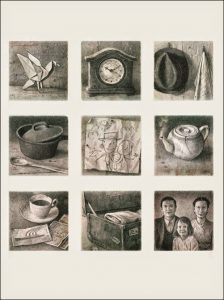In class today, we talked about how Shaun Tan’s book, “The Arrival”, includes the reader in the process of this narrative. One way in which he does this is exhibited in the photograph below. This is the first page of the book, and it shows items in isolation from the protagonist’s home in his country of origin. It is the reader’s job to make a mental cohesion out of them, and to see these items as you would the items in your own home. The objects are seemingly indistinguishable from everyday ones but just personable enough that if they were in your own home — the cracked tea pot, the curvature on the clock — you would associate nostalgic feelings of home with them.
Shaun Tan also includes the reader in the protagonist’s feelings of displacement and confusion by creating a fictional city for him to immigrate to with a nonsense language. As a result of this, no one reading this book can be a native of this new country with more knowledge of it than the main character– everyone is an immigrant. Every page, we learn as he does about his new home — the types of food, the traffic, the ways of life, etc. It allows us to empathize in a more authentic way with the main character than we could if he was moving to America or even a different country that we may know more about.
And the fact that it has no textual narration means that readers have to pay close attention to the emotion on the protagonist’s face, his reactions to the new context that he’s placed in. We are guided by him and see everything through his lens, and therefore we are constantly empathizing with his emotional experience.


It’s interesting to think about that scenario of, if you had to up and leave, what would you take? For most we would probably take objects that a lot of other people have ie. photographs, a watch, a work of art. Yes, they are individual objects that we hold dear but they are also normal, mundane, everyday things. I think Tan incorporates this into The Arrival with, as you said, the image of those objects and also the images of his characters. We often don’t see the male protagonist’s face, because we are all him. There is a specialness in the unspecial that we all must treasure.